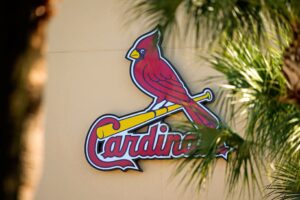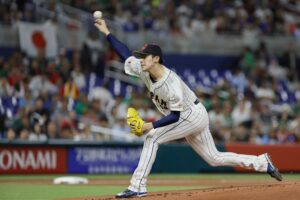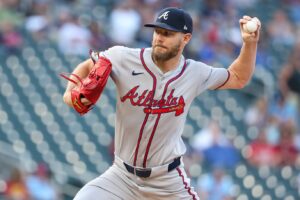Madison Bumgarner “No-hitter”: The Fair Thing to Do
When Major League Baseball decided to make all double header games seven innings in 2020, the reason was “health and safety.” They kept it in 2021 for the same reason. We all knew it would change some aspects of the game. Few, if any, brought up a rare, yet not unheard of, what-if — “What if someone throws a no-hitter?” After all, these games were being shortened by design before the first pitch was even thrown. We never received an answer — but then again, no one really asked the question loud enough, either. Maybe the prevailing thought was that no-hitters are so rare that it wouldn’t happen in a seven-inning game that was part of a double header. Well, Sunday afternoon in Atlanta, it happened. Arizona Diamondbacks left-hander Madison Bumgarner not only threw a seven-inning no-hitter against the Atlanta Braves, but he faced the minimum number of batters, 21.
Diamondbacks manager Torey Lovullo said, “Seven innings, nine innings — it’s a no-hitter.” He added, “You know what the task is and whom you’re playing against. These are major league hitters — good major league hitters — that he shut down for seven complete innings.” Catcher Carson Kelly agreed. “It’s still a no-hitter. Today we came in knowing it was a seven-inning game. That’s what we were told — a seven-inning game. We gave up no hits in seven innings.” Braves first baseman Freddie Freeman felt the same way. “I think it’s a no-hitter. We had a game today, we didn’t get any hits, and he pitched the whole thing.”
But according to the current rules, it’s not. Consequently, for the first time in major league history, a pitcher pitched in every scheduled inning of a game without allowing a hit yet did not receive credit for pitching a no-hitter.
Committee for Statistical Accuracy Ruling, September 1991
This came as the result of a September 1991 meeting of the eight-member committee for statistical accuracy. The committee, which included then-Commissioner Fay Vincent and seven highly regarded baseball minds, ruled that a pitcher must pitch nine or more innings without allowing a hit. This eliminated 50 no-hitters from the books, including a few that came in games shortened by weather or darkness. Others that went away were games where the pitcher threw nine hitless innings but gave up a hit in extra innings. The most famous game was that of Pittsburgh Pirates hurler Harvey Haddix, who pitched 12 perfect innings in a 1959 game against the Milwaukee Braves, only to lose the perfect game, then the no-no, then the game itself on three consecutive batters in the 13th.
Andy Hawkins
Some others — including a July 1, 1990 game between the New York Yankees and Chicago White Sox — were no-hit losses. This particular one came from Yankees pitcher Andy Hawkins. In the bottom of the eighth, having walked three without allowing a hit in a scoreless game, Hawkins retired the first two batters. Sammy Sosa then hit a two-hopper to third, where Mike Blowers muffed it and could not throw out the speedy Sosa at first. After Sosa stole second, Hawkins walked Ozzie Guillen and Lance Johnson to load the bases.
That brought up Robin Ventura, who hit a lazy fly ball to deep left. Jim Leyritz tracked it down but stumbled on his last step. The ball glanced off his glove and rolled into the left-field corner, clearing the bases as Ventura reached second. Due to two errors, Hawkins was now behind, 3-0, despite giving up no hits. The next batter, Ivan Calderon, lofted a high fly to right. Jesse Barfield dropped it, scoring Ventura as Calderon reached second. After Dan Pasqua popped to short for the third out, Hawkins trailed, 4-0, despite not allowing a hit.
The Yankees did not score in the ninth. Since the host White Sox were ahead after eight and a half innings, the game ended, so Hawkins did not pitch the bottom of the ninth. Under the rules of the time, Hawkins had a no-hitter. One year later, he did not.
Precedent for an Official No-Hitter
The precedent seemed clear — pitch in every inning of the game without allowing a hit. If the game ended earlier than scheduled, then sorry — it wasn’t an official no-hitter. The philosophy behind that also seemed reasonable. Games were always scheduled to go nine innings. When they didn’t, it was due to interference by an outside agent — weather, darkness, curfew, having to catch a train, or, in the case of an August 10, 1995 game at Dodger Stadium, angry fans throwing souvenir baseballs onto the field. Teams came to the field expecting to play nine, so they strategized accordingly. When the game ended early, it was like a rug being pulled out from under them.
The seven-inning double header games changed that. These were shorter because the league planned them that way. Both teams knew before the first pitch that these games would last seven innings. They planned and strategized accordingly. If a team was within striking distance in the seventh, that’s when they would pull out all stops, using pinch-hitters and pinch-runners and, if it were in the “old days,” sacrifice bunts.
An Apparent Contradiction
There is an argument that, now, the insistence that no-hitters must be nine innings or longer — even if the game was scheduled in advance by the league to be seven — contradicts another stance taken by the 1991 committee that made this rule. In the very same meeting where they made the “no-hitters must be at least nine innings” rule, they removed the separate listings for the single-season home run record. Babe Ruth hit 60 in 1927. Roger Maris hit 61 in 1961. However, in 1961, the American League played eight more games due to expansion. Maris did not even tie Ruth until the 159th game, and he passed Ruth in Game 162. Therefore, the record book listed two single-season home run records — one for a 154-game season, and another for a 162-game season. The 1991 committee ruled that “a season is a season,” regardless of length.
However, saying “a no-hitter is a no-hitter, regardless of length” isn’t quite the same. For one, pitchers aren’t competing against other pitchers to do this — they’re competing against perfection. Secondly, pitchers have lost no-hitters in the eighth or ninth many times. To treat a seven-inning no-hitter the same as a nine-inning no-hitter is unfair to those pitchers.
The Fair Thing to Do with the Madison Bumgarner No-hitter
But baseball also can’t simply pretend the seven-inning no-hitter, such as the one Bumgarner threw, never happened. They can’t do that for any that might happen in the future, either. Here is a solution — do what Ford Frick had the league do with the Roger Maris home run record. Start a new index entry for “No-hitters in a Scheduled Seven-Inning Game.” Make Madison Bumgarner the first entry. Since early signs show that the players will not approve seven-inning double headers beyond this season, he may be the only one. If others throw one in 2021, then he won’t. Either way, it’s the fair thing to do.
Baseball entered uncharted waters by making all double-header games seven innings long. It is time for them to do the same with the record book. The Madison Bumgarner no-hitter may not have been a “real one,” as some have said, but it’s a remarkable accomplishment, nonetheless. Several key people — including players from both teams — consider it a no-hitter. Other prominent voices — including John Thorn, the official Historian for Major League Baseball — consider it a no-hitter as well. Yes, it was a shorter game, but that was due to design, not interference. So let’s make a new entry.
Bumgarner pitched every scheduled inning of a game without allowing a hit. Let’s recognize that, even if it means doing something new in the record book.
Main Photo:
Embed from Getty Images
Players/Managers Mentioned:
Madison Bumgarner, Torey Lovullo, Carson Kelly, Freddie Freeman, Harvey Haddix, Andy Hawkins, Sammy Sosa, Mike Blowers, Ozzie Guillen, Lance Johnson, Robin Ventura, Jim Leyritz, Ivan Calderon, Jesse Barfield, Dan Pasqua, Babe Ruth, Roger Maris






